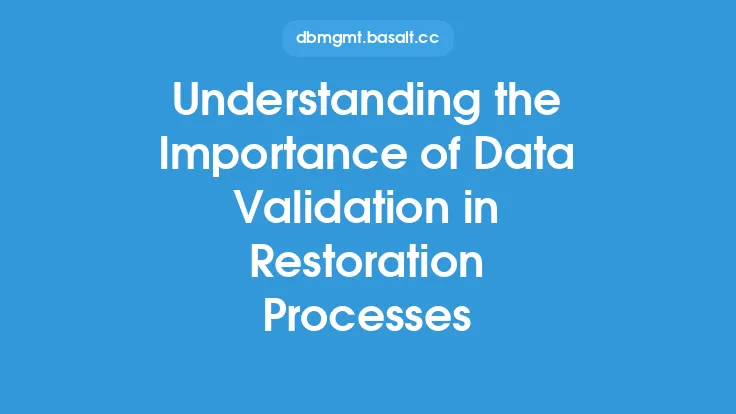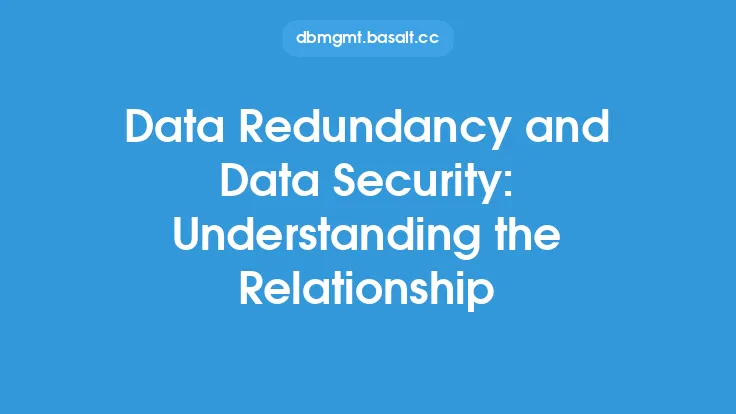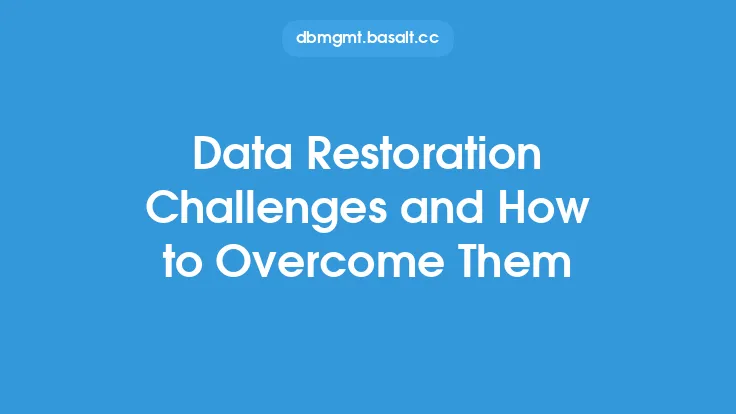Data restoration and backup are two fundamental concepts in the realm of database management, often used interchangeably but carrying distinct meanings. Understanding the differences between these two processes is crucial for database administrators, as it directly impacts the effectiveness of their database backup and recovery strategies. In this article, we will delve into the world of data restoration and backup, exploring their definitions, purposes, and the key differences that set them apart.
Introduction to Data Backup
Data backup refers to the process of creating copies of data to prevent loss in the event of a disaster, hardware failure, or other catastrophic events. The primary goal of data backup is to ensure that data is preserved and can be recovered in case the original data becomes inaccessible or is lost. Data backups can be performed manually or automatically, depending on the organization's requirements and the type of data being backed up. There are several types of data backups, including full backups, incremental backups, and differential backups, each serving a specific purpose in the backup and recovery process.
Understanding Data Restoration
Data restoration, on the other hand, is the process of retrieving and recovering data from backup copies to restore the database to a consistent state. This process is typically performed after a disaster or data loss event, with the goal of minimizing downtime and ensuring business continuity. Data restoration involves several steps, including identifying the backup copies to be used, restoring the data to a temporary location, and then applying the restored data to the production database. The complexity of the data restoration process depends on the type of backup used, the size of the database, and the level of data corruption or loss.
Key Differences Between Data Backup and Restoration
While data backup and restoration are closely related, there are significant differences between the two processes. The primary difference lies in their purposes: data backup is focused on creating copies of data to prevent loss, whereas data restoration is focused on recovering data from backup copies to restore the database. Another key difference is the timing of these processes: data backup is typically performed on a regular schedule, whereas data restoration is performed on an as-needed basis, usually in response to a disaster or data loss event. Additionally, data backup is often an automated process, whereas data restoration typically requires manual intervention to ensure that the data is recovered correctly and the database is restored to a consistent state.
Technical Considerations for Data Backup and Restoration
From a technical perspective, data backup and restoration involve several key considerations. For data backup, these include the type of backup to be performed (e.g., full, incremental, or differential), the frequency of backups, and the storage media to be used (e.g., tape, disk, or cloud). For data restoration, technical considerations include the type of restore to be performed (e.g., full, partial, or point-in-time), the location of the backup copies, and the tools and software to be used for the restoration process. Database administrators must also consider factors such as data consistency, transactional integrity, and system performance when designing their backup and restoration strategies.
Best Practices for Data Backup and Restoration
To ensure effective data backup and restoration, several best practices should be followed. For data backup, these include scheduling regular backups, testing backup copies to ensure their integrity, and storing backup copies in a secure, offsite location. For data restoration, best practices include developing a comprehensive restoration plan, testing the restoration process to ensure its effectiveness, and performing regular restores to ensure data consistency and integrity. Additionally, database administrators should consider implementing a backup and restoration strategy that includes multiple layers of protection, such as backups, snapshots, and replication, to ensure that data is fully protected and can be recovered in case of a disaster.
Conclusion
In conclusion, data restoration and backup are two distinct processes that play critical roles in database management. While data backup is focused on creating copies of data to prevent loss, data restoration is focused on recovering data from backup copies to restore the database. Understanding the differences between these two processes is essential for database administrators, as it directly impacts the effectiveness of their backup and recovery strategies. By following best practices and considering technical factors such as data consistency, transactional integrity, and system performance, organizations can ensure that their data is fully protected and can be recovered in case of a disaster, minimizing downtime and ensuring business continuity.





